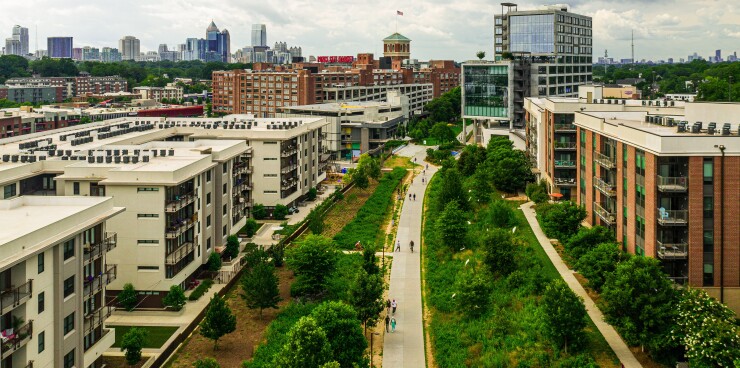Atlanta is taking another step forward on a massive urban revitalization project nearly two decades in the making.
City officials this week commissioned a transit planning study for a 13-mile stretch of the Atlanta BeltLine project, an effort launched in 2005 to create a network of public parks, pedestrian paths, and new transit options centered around a 22-mile loop of disused railroad tracks circling Atlanta’s downtown.
The project seeks to connect 45 of the city’s neighborhoods with the new transit options and is slated for completion in 2030. Supporters say it will provide a $20 billion boost to the local economy.
Adobe Stock
The study will be supported by federal transportation grants and will attempt to identify locations for new train stations as well as connection points for existing transit options along a 13.6-mile stretch of the loop in Atlanta’s northwest, said a press release from the publicly-managed project lead Atlanta BeltLine Inc.
“Transit is at the heart of the BeltLine vision,” said Atlanta BeltLine President and CEO Clyde Higgs. “The BeltLine is about high-quality ways to connect people to jobs, health care, shopping, education, and opportunity while making Atlanta a more mobile city. Rail transit is key to how we do that.”
The Beltline project currently carries a cost of $4.8 billion, which will be covered through a mix of funding sources that includes county, state, and federal grants, and potential public-private partnerships.
Local funds come in part from the BeltLine Tax Allocation District which was created in 2005 and covers the area around the planned transit loop and allowed to levy taxes on area businesses and property owners that stand to see benefit from the public investment.
However, the Beltline TAD proved insufficient alone to see the project through to completion, and in 2021 the Atlanta City Council created a corresponding Special Service District, empowered to set a targeted tax towards commercial and multi-family property owners to raise as well as make decisions on debt issuances on the project’s behalf.
Bonding allows the city to finance construction more quickly, officials said, reducing capital costs while kickstarting economic development and TAD growth, and in December 2021, the city closed the sale of $95.1 million of SSD bonds through AURA.
City officials said they’ve already put $670 million of public funds toward the project, in addition to $8 billion in private investments in the area, and while several stages of the project are behind schedule, they’ve marked the completion of a number of permanent pedestrian trails, 315 acres of new and renewed parks and greenspaces, the remediation of 396 acres of brownfields, and the creation of several planned affordable housing developments.
The new study will take around two years to complete with work, including field investigations and environmental screenings, to public outreach efforts, ridership forecasts, and financial planning, carried out by New Jersey-based design consulting firm Kimley-Horn & Associates.
